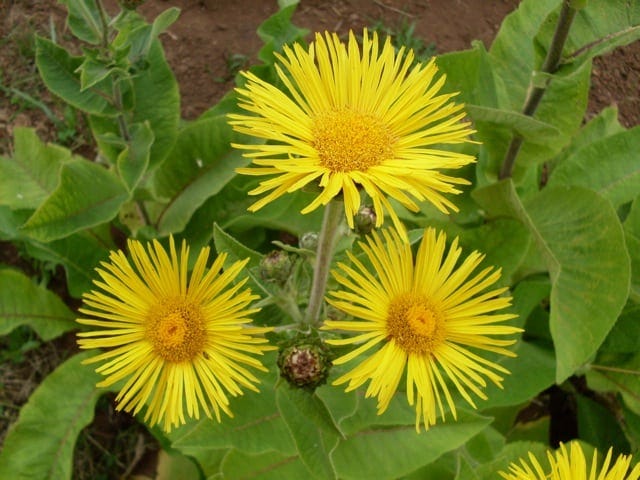Elecampane, scientifically known as Inula helenium, is one badass medicinal plant that's been helping humans kick illness to the curb for centuries. This impressive perennial can grow up to 8 feet tall with bright yellow flowers that look like they're flipping off the sun itself. Ancient Greeks and Romans weren't stupid - they knew this plant was the shit and used it regularly for respiratory conditions and digestive issues that would otherwise leave people feeling like crap. The plant gets its name from Helen of Troy, because apparently it sprouted from where her tears fell, which is both poetic and metal as hell if you think about it. Throughout European history, this herb was so valued that people would grow it specifically near their houses so they could grab it whenever someone started hacking up a lung or complaining about their damn stomach problems.
Description
Elecampane is a tall, sturdy plant that looks like it could beat up most other plants in your garden without breaking a sweat. The leaves are huge, rough, and oval-shaped with toothed edges that can span up to 2 feet long - basically the plant equivalent of someone who definitely lifts. Its flowers are striking yellow sunburst-looking things with skinny petals that radiate from a central disk, blooming from July to September like they're showing off. The most valuable part is the thick, fleshy root that smells intensely aromatic - kind of like violets mixed with camphor and a hint of "don't mess with me" energy. When cut, the root reveals a yellowish interior that can stain your hands if you're not careful, like it's marking you as its own. The plant establishes itself like it owns the place, creating a robust presence that stays put for years once it decides your garden is its territory.
Cultivation Section
Growing elecampane isn't rocket science, but it does demand respect and proper conditions or it'll give you the botanical equivalent of the middle finger. This herb thrives best in rich, moist soil with good drainage, because it wants the good life but doesn't like wet feet – sounds like most of us after a long day. Plant this beast in full sun to partial shade, giving it plenty of space since it grows big as hell and will crowd out weaker plants without an ounce of remorse. Start from root divisions or seeds in spring, but be patient because seeds can take their sweet time to germinate, sometimes up to a month while they decide if your garden is worthy. Once established, this plant is tough as nails and will return year after year with minimal maintenance, basically the plant version of that friend who always shows up uninvited but brings good beer.
Medicinal Uses
Respiratory Support
Elecampane root contains compounds that tell bronchial mucus to get the hell out, making it excellent for clearing congestion. Its expectorant action has been helping people breathe better through colds, bronchitis, and asthma since before modern medicine got its act together.
Digestive Aid
This herb kicks digestive problems right in the ass with its bitter principles that stimulate digestive secretions and improve appetite. It soothes the gut lining while eliminating unwanted gas and bloating that makes people miserable and unpopular in crowded elevators.
Antimicrobial
Elecampane contains alantolactone and other compounds that tell bacteria and parasites to fuck off and die. Research has shown it's particularly effective against Staphylococcus aureus and certain intestinal parasites that have overstayed their welcome.
Anti-inflammatory
The plant's sesquiterpene lactones reduce inflammation in the body without the side effects of pharmaceutical options. Studies show it can help with joint pain and other inflammatory conditions when your body's being a drama queen with its inflammatory response.
Immune Support
This root strengthens the immune system by enhancing the body's natural defenses against the countless microscopic assholes trying to make you sick. Regular consumption during cold and flu season might just be the difference between being functional and being that pathetic heap under blankets for a week.
How to Use
Keep reading with a 7-day free trial
Subscribe to Wendy The Druid to keep reading this post and get 7 days of free access to the full post archives.



